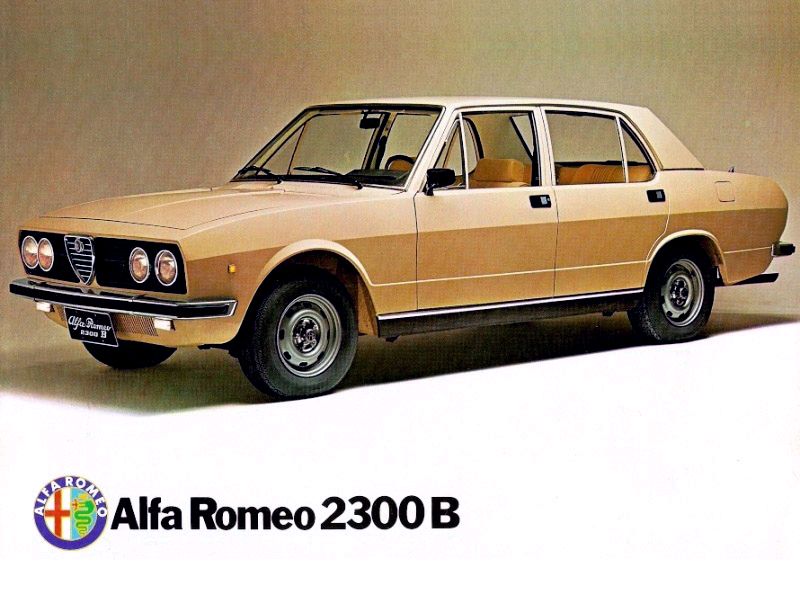In 1974, Brazil’s automotive landscape transformed with the arrival of a car that would redefine luxury motoring in South America. The Alfa Romeo 2300 B emerged from an unprecedented collaboration between Italian engineering prowess and Brazilian manufacturing capability.
The partnership between Fábrica Nacional de Motores (FNM) and Alfa Romeo represented more than just another business venture. It marked Brazil’s ambitious step into the world of premium automotive manufacturing, bringing sophisticated European technology to the streets of Rio de Janeiro and São Paulo.
A Marriage of Two Automotive Cultures
The story of the 2300 B began when Alfa Romeo acquired FNM in the 1960s. Brazil’s growing economy demanded vehicles that could match international standards while handling local conditions. Engineers from both countries worked side by side, creating a unique blend of Italian sophistication and Brazilian practicality.
The development team faced unique challenges. They needed to maintain Alfa Romeo’s reputation for performance while adapting to Brazilian fuel quality and road conditions. The result exceeded expectations, proving that premium automobiles could be successfully manufactured in South America.
Historical Reference!
The FNM factory in Rio de Janeiro employed over 3,000 workers during peak production of the 2300 B, making it one of Brazil's largest automotive employers in the mid-1970s.
“The 2300 B wasn’t just another luxury car — it represented Brazil’s coming of age in the automotive world,” remarks Carlos Santos, a renowned classic car collector. “When you see one today, you’re looking at a piece of both Italian and Brazilian industrial heritage.”
The car’s development marked a turning point for Brazil’s automotive industry, demonstrating the country’s capability to produce vehicles that could compete with international standards.
Engineering That Defied Expectations
At the heart of the 2300 B sat a masterpiece of engineering: a 2.3-liter twin-cam engine producing up to 141 horsepower. This powerplant represented a significant technological leap for Brazilian manufacturing, featuring sophisticated dual overhead camshafts when most domestic vehicles used simpler designs.
Performance figures tell an impressive story:
- 0-100 km/h acceleration in 11.7 seconds;
- top speed of 171 km/h;
- power delivery through a refined 5-speed manual transmission;
- advanced suspension system for superior handling.
Fact!
The 2300 B's engine was so well-engineered that several examples have surpassed 300,000 kilometers while maintaining their original mechanical components.
The vehicle’s engineering excellence extended beyond its powertrain. The chassis design, suspension geometry, and brake system were carefully tuned for Brazilian roads while maintaining the handling characteristics Alfa Romeo was famous for.
Luxury Meets Functionality
The 2300 B’s exterior design balanced elegance with presence. Its 4,719mm length and 1,692mm width created an imposing silhouette that commanded respect on Brazilian streets. Chrome accents and distinctive Alfa Romeo styling cues emphasized its premium positioning.
“I remember the first time I sat in a 2300 B,” shares Roberto Mendes, former executive and 2300 B owner. “The leather seats, wood trim, and overall build quality were unlike anything else available in Brazil at the time. It made you feel like you were driving something truly special.”
Interior comfort received particular attention. The cabin featured high-quality materials and ergonomic design that set new standards for the Brazilian market. Every control and switch operated with precision that reflected its Italian heritage.
Important!
The 2300 B pioneered several safety features in the Brazilian market, including dual-circuit braking systems and collapsible steering columns.
Climate control and sound insulation were optimized for tropical conditions, demonstrating the successful adaptation of European luxury standards to South American requirements.
A Legacy That Endures
Today, the Alfa Romeo 2300 B holds a special place in automotive history. Its production run from 1974 to 1978 yielded vehicles that continue to captivate enthusiasts and collectors. The model’s influence extended beyond its sales numbers, inspiring future generations of Brazilian automotive engineers.
Preservation efforts have intensified as the car’s historical significance becomes more widely recognized. Dedicated owner clubs maintain detailed records and share restoration expertise, ensuring these vehicles remain on the road for future generations to appreciate.
Notice!
Original parts availability remains surprisingly good, thanks to the efforts of specialized Brazilian workshops that manufacture high-quality replacements.
The 2300 B’s story demonstrates how international collaboration can produce extraordinary results when engineering excellence meets local expertise.
Beyond the Numbers
The Alfa Romeo 2300 B represents more than just impressive specifications and luxurious features. It stands as a testament to Brazil’s industrial capabilities and the success of international automotive partnerships.
Looking back, the 2300 B achieved something remarkable: it proved that premium vehicles could be successfully manufactured in South America without compromising on quality or performance. This legacy continues to influence Brazil’s automotive industry today.
| Pros | Cons |
|---|---|
| Advanced DOHC engine technology with impressive performance | Limited parts availability for some specialized components |
| High-quality interior materials and craftsmanship | Higher fuel consumption compared to contemporary domestic models |
| Successful adaptation of European technology for Brazilian conditions | Complex mechanical systems require specialized maintenance |
| Strong collector value and historical significance | Restoration costs can be substantial |
| Pioneering safety features for the Brazilian market | Rust protection technology was still developing in the 1970s |
| Comfortable ride quality suitable for various road conditions | Performance figures modest by modern standards |
| Distinctive Italian-Brazilian design heritage | Some electrical components can be challenging to source |
The Alfa Romeo 2300 B represents a unique chapter in automotive history where Italian engineering excellence successfully merged with Brazilian manufacturing capabilities. While it presents certain challenges for modern ownership, its historical significance and driving experience make it a compelling choice for collectors and enthusiasts who appreciate its distinctive heritage. The model’s enduring influence on Brazil’s automotive industry underscores its importance beyond mere transportation.

